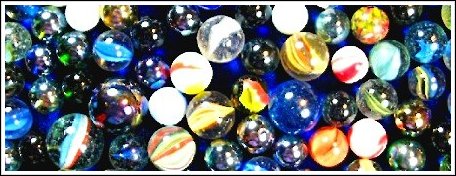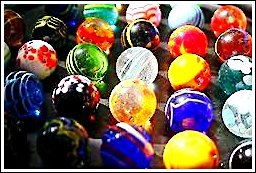Have You Lost Your Marbles?

"Marbles Champ" by Norman Rockwell

Have you lost your marbles? The question could be interpreted as a reference to one’s mental state or the loss of a marble collection as in those used in a child’s game. This article deals with the latter. Because of the marble’s ancient history, it’s not certain when and where they actually originated.
The Encyclopedia Britannica defines a Marble as “…a small, hard ball used in a variety of children's games and is named after the 18th-century practice of making the toy from marble chips.”
The world's largest producer of marbles is currently Vacor de Mexico located in Guadalajara. They make about 90 percent of the world’s marbles. That translates into approximately 12 million per day which they ship to 35 different countries. Today, marbles are still produced in large numbers, but mostly in 3rd World countries.
Some historians would say Marbles originated in Pakistan near the river Indus where some stone marbles were excavated. Others would say they came from ancient Rome and Egypt. Yet others believe marbles started with cave people playing with small pebbles. They’ve even been found in ancient Aztec pyramids. The oldest marbles found so far date from around 3000 BC. They were rounded semi-precious stones buried with an Egyptian child. So, take your pick.
Marbles are frequently referred to in Roman documents, and many different types have been discovered in ancient Egyptian tombs. Some have been found dating back to the ice age. They were commonly made of clay, stone or glass.

Common materials used to make more recent marbles were china, real marble and glass and were all made by hand up until 1848. That was the year a German glass blower invented the marble scissor. It resembled a pair of tongs with a small cup on one end and a slicing device on the other and made production much easier.
It is thought there are only three places in the world still crafting marbles in the traditional manner. In North America, engraved marbles have been found in ancient Native American earthen mounds. Apparently, ancient peoples played marbles the same as they do today.
History records such notables as George Washington, Thomas Jefferson and John Quincy Adams were marble players, as was Abraham Lincoln. The game of marbles became so popular, a World Marble Championship has been held at Tinsley Green, West Sussex, England since 1932. The Green itself has seen marble contests for centuries. Marble history there can be traced back to around 1588.
It should come as no surprise many have made marble collecting a hobby, happily pursued by kids as well as adults. Did you know in the early 20th century, boys loved to collect marbles as well as play with them? Marble collecting was very fashionable during that period. Most antique marble collections today are actually collections once owned by them.
To start a marble collection, it’s advisable to study about histories and types. It’s difficult to identify one by a cursory glance. Many have similarities only a thorough knowledge of marbles can discern. Having such knowledge is a protection against fraud or selling off something worth thousands of dollars. For further information about marble collecting as a hobby visit: http://www.marblesonline.com/
The earliest known book written about marbles was written and published in England in 1815. It verified marbles at that time were made of china, clay, glass or even real marble. Researchers say the first marbles made by machines appeared in Germany in 1890. The first hand made glass marbles manufactured in America for the toy market were made by the Sam Dyke & Company in Akron, Ohio about the same time.
This factory was able to produce up to one million marbles a day. Mass production allowed the retail price of a toy marble affordable. Previously a penny wouldn’t have bought a single common ordinary clay marble (called "commies.") Now, for that price, one could get a whole handful. The technique to produce perfectly spherical marbles was not developed until after 1900.
Today, marbles are made from sand, soda lime, silica, and a few other ingredients added for pigment and decoration such as aluminum hydrate or zinc oxide. Soda lime is used as a drying agent and absorbs carbon dioxide.





